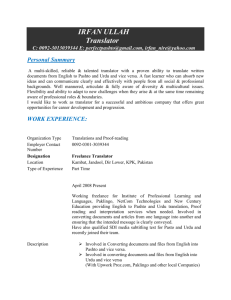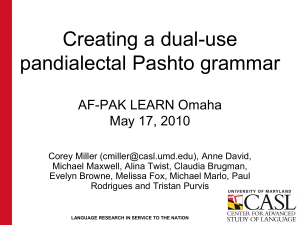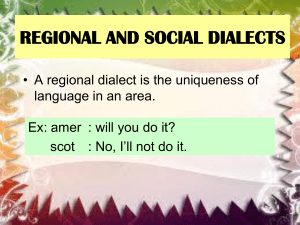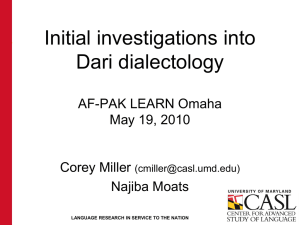Presentation
advertisement
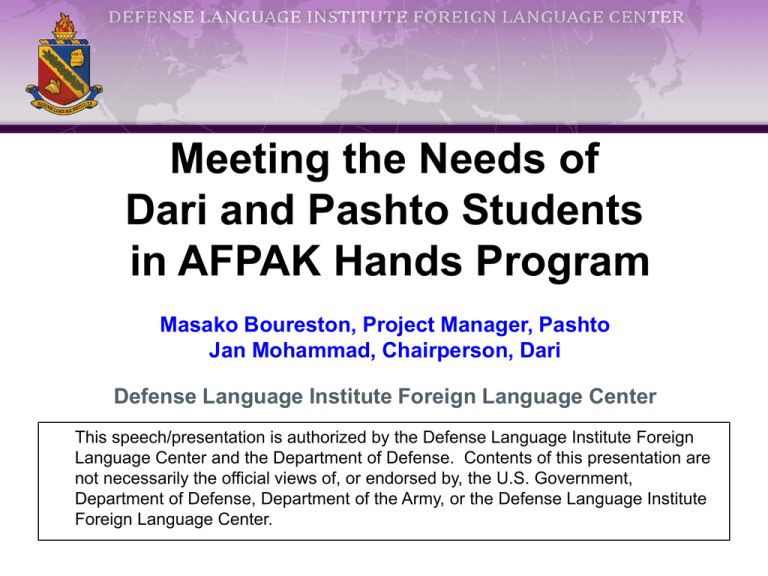
Meeting the Needs of Dari and Pashto Students in AFPAK Hands Program Masako Boureston, Project Manager, Pashto Jan Mohammad, Chairperson, Dari Defense Language Institute Foreign Language Center This speech/presentation is authorized by the Defense Language Institute Foreign Language Center and the Department of Defense. Contents of this presentation are not necessarily the official views of, or endorsed by, the U.S. Government, Department of Defense, Department of the Army, or the Defense Language Institute Foreign Language Center. Overview • Background of Dari and Pashto Programs & AFPAK HANDS • Needs of students • Elements to consider Pashto/Dari Training • Pre-deployment Familiarization • AFPAK Hands (Phase 1 = 16 wks) • Basic Course: – 47 wks (Dari) – 63 wks (Pashto) …and further training (e.g. dialect) AFPAK HANDS • • • • Started in July 09 Pilot of phase 1 (16wks) : Sept 09 - Present Small scale revisions based on feedback Needs Analysis in March 2010 AFPAK Hands Needs Analysis © DoD Media AFPAK Hands Needs Analysis Dari/Pashto • Varying assignments in Afghanistan • Language needed (Pashto > Dari) – Survival level phrases – Conversational skills • Specific language functions mentioned • Cultural knowledge and survival skills needed – e.g. dealing with women, elders, etc. WHAT is requested • Language training Survival phrases ----------- Basic conversation Job-related skills/language (Military-related scenarios, Tactical vocabulary) • Cultural knowledge Challenges • Identify the language/dialect needed • Introduce REAL culture (what and how?) • Tactical language for novice learners Balance of Job-specific ------- General language • Simplified course structure needed Type of Language Dari - Spoken and Formal language Pashto - Dialect “Standard” Dialect - a dialect that is supported by institutions. ( “Standard” Pashto?) ILR on “standard language” • (LC) L1: ……can understand simple questions and answers, simple statements and very simple face-to-face conversations in a standard dialect. • (LC) L2: Able to understand face-to-face speech in a standard dialect. • (LC) L3: Has effective understanding of face-to-face speech, delivered with normal clarity and speed in a standard dialect on general topics and areas of special interest • (LC) L4: Able to understand the essentials of speech in some non-standard dialects. • (LC) L4+: Increased ability to comprehend native speakers using extreme nonstandard dialects and slang. ILR on “cultural reference” • (SP) L2+: The individual may miss cultural and local references and may require a native speaker to adjust to his/her limitations in some ways. • (SP) L3: Although cultural references, proverbs, and the implications of nuances and idiom may not be fully understood, the individual can easily repair conversation. • (LC) L3+: Ability to comprehend many sociolinguistic and cultural references. • (SP) L4: Organize discourse well, using appropriate rhetorical speech devices, native cultural references, and understanding. Elements to Consider • Students: aptitude, motivation, job-skills • Language Input: materials, dialect, levels • Learning Environment: delivery, content, practice, What happens in the class, What learners DO HOW learners learn Synthetic Syllabus Language in small parts Analytic Syllabus Language as a whole Lessons (being) Learned • Different approach needed for learners who need TL for “specific purposes” • “Survival” skills = NOT the same as using memorized words and phrases, or simple sentences • Greater understanding of culture and people needed • Consider “environmental factors” Process: Outcom e Learning experience, Type of practice, Delivery of Lang. & Culture What happens in the class? Input: Language Dialect Cultural knowledge Functions Aptitude Motivation Job-skills… 0 Action Plans for modifying BC materials • • • • • More emphasis on LC/SP Simplified lesson routines Job-relevant topics, and tasks Transliteration as needed From grammar-driven course to conversation/situation driven course • Simplified grammar notes • Coordination with other groups/organizations • Culture elements embedded systematically Questions?

